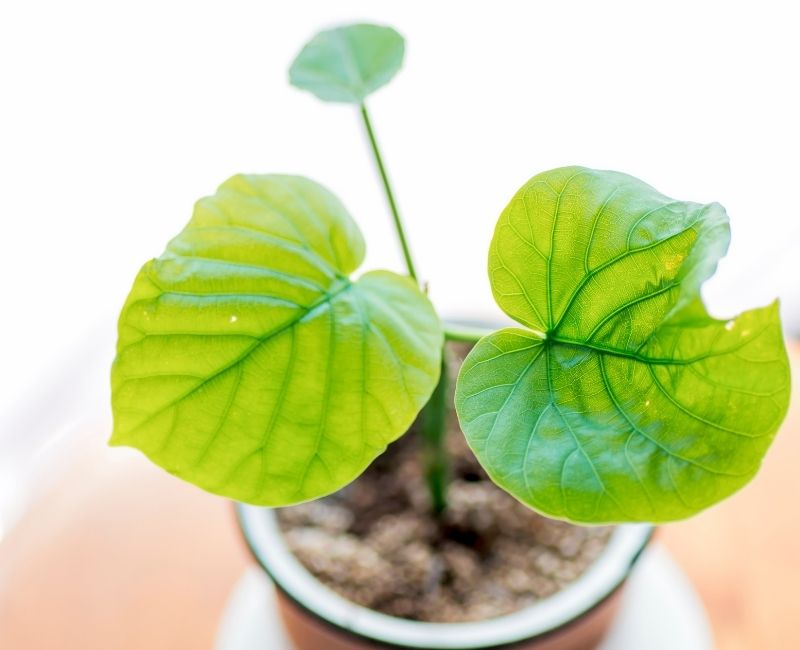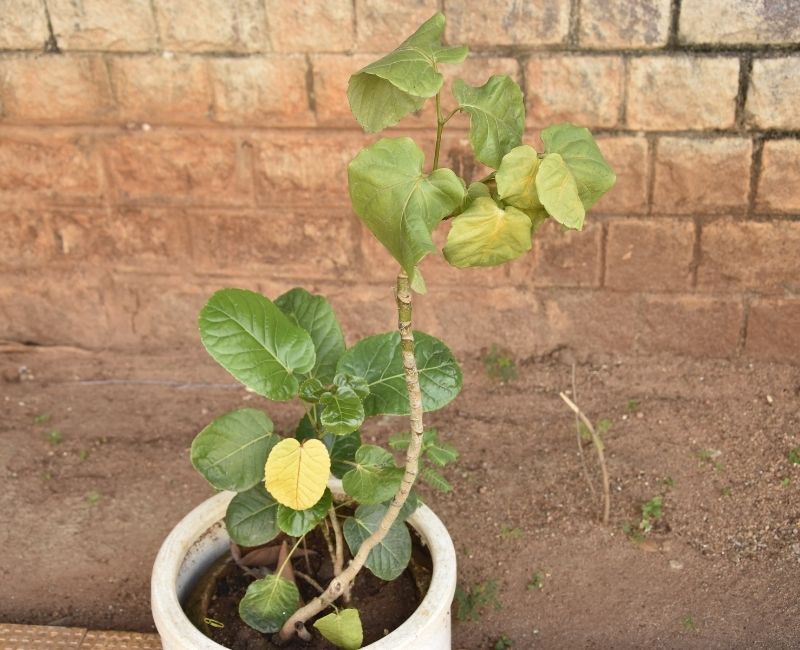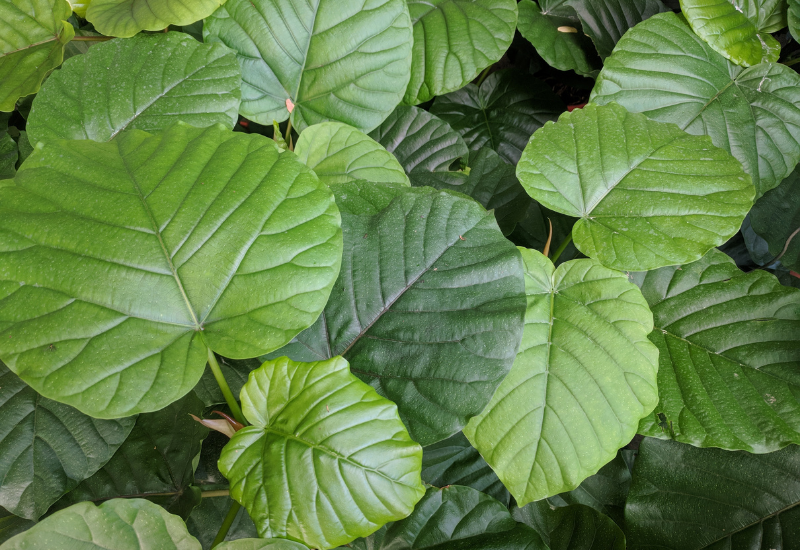Ficus umbellata is known for its wide, unique heart-shaped leaves and also thin stems. This type of plant makes an excellent indoor specimen because it can grow well in medium-high light conditions and be pruned into different shapes if desired. It’s easy to care for, offers a lot of variety in color and leaf shapes, and is relatively inexpensive. However, it can be challenging to maintain your ficus plant if you don’t know what you’re doing.
Ficus Umbellata Care Guide Overview
- How To Plant (when & where)
- How To Grow (staking, watering, fertilizing, humidity, mulching)
- How To Trim And Prune
- How To Pot And Repot
- How To Propagate (when & how)
- And Pests and Diseases, Plant Species, Companions, Toxicity
Characteristics
- Scientific name: Ficus umbellata
- Common names include umbrella tree fig, Indian laurel, Weeping Fig tree. It has a weeping habit, meaning that it will droop its branches down to the ground.
- Origin: From Africa
- Indoor or Outdoor plant: Indoor plant. This evergreen plant prefers living in warm climates. Incase of being planted outdoors, it needs protection from frost and direct sunlight.
- Height and Structure: The plant has an oval canopy with dark green leaves about 1 inch wide and 2 inches long. The plant can still grow up to 12 feet tall
- Temperature: Prefers temperatures ranging from 65 to 85 degrees Fahrenheit. It will not withstand chilly breezes, so it is good to keep away from drafty regions.
- Flower Color: yellow
How To Plant the Ficus Umbellata

Planting Time
The Ficus Umbellata plant prefers warm weather and can be bought at any time of year if you live where there is consistent warmth throughout the year. The best planting times are spring and fall when it is not too hot or cold outside. This is when temperatures outside remain above 50 degrees Fahrenheit (or about 11 Celsius).
You can also plant your new tree in winter if you live in an area where the weather does not get below freezing for long periods. Springtime tends to have more rainfall than summer, so this might also be a good choice if you want to ensure that your soil has enough moisture after being planted.
Make sure that there isn’t another frost coming before planting your new tree. This will kill off the roots of your young sapling and could potentially harm other plants around it as well.
If possible, find someone with experience who knows how high up they should plant the tree.
Spacing
Space your Ficus Umbellata tree so that they are about four to six feet apart. This will allow them room for growth but still be close enough together where sunlight and other resources can reach all of the trees without difficulty. The more dense coverage you have, the less light each individual plant gets- even if it is a sunny day outside.
Give them enough room space to stretch out their roots and foliage later on when they begin to mature in size. You do not want overcrowding with this type of plant because you might run into diseases or pests that could harm your new plants before they get established. Spacing at least four feet apart is recommended, while spacing up to six works best depending on how much space is available.
Remember, the more room they have to grow, the taller they will potentially become. Keep them trimmed back, so they don’t overtake neighboring plants. These trees need plenty of sunlight.
Light
Provide lots of light. Ficus plants are naturally found in tropical rainforest climates where there are plenty of sunlight hours throughout the day. For this reason, they require an abundance of bright but indirect natural sunlight from large windows or other sources. If there is no natural light coming into your home or office, consider supplementing with grow lights.
Soil
The soil for your Ficus Umbellata plant should be a rich, dark color and have good drainage. One can make his or her own mixture by adding one part potting soil, one part compost, and one part sand.
Make sure you break up all the large clumps in the potting soil before adding it to the mixture or else your plant’s roots might become constricted as they grow. Adding some organic matter such as compost will help keep the soil healthy while also providing nutrients that the tree will need to thrive.
A sandy component is important because it helps with drainage you don’t want waterlogged soils because this will lead to root rot and other diseases. If you use a container instead of planting directly into the ground, make sure the pot has drainage holes at the bottom so excess water can escape.
How To Grow the Ficus Umbellata

Growth habits
The Ficus Umbellata is an evergreen that grows pretty quickly, which can be a problem if you grow them in containers. These trees grow best when they have plenty of space to spread their roots out and get larger- don’t overcrowd your plant.
The size of the pot should reflect this growth rate, so make sure it’s large enough for your tree to fill up with roots but not too big otherwise, the extra soil around will retain moisture leading to root rot or other diseases.
Since this type of ficus does not tolerate frost, you must take care to protect them during cold winter months by moving their container into an unheated garage or porch. Also make sure that the soil remains moist throughout the colder seasons so that your plants do not dry out too much.
Staking
If you want your ficus tree to grow as tall as possible, then consider staking it during the first few years. You can use any type of stake that you want as long as it is sturdy.
Push the stake next to the plant and tie the stem to the stake with some twine or gardening wire. Make sure not to tighten the wire too much around the stem or you could damage it. This will help keep the top of the tree from breaking under its own weight and allow for a straighter trunk overall which can also reduce crowding that occurs once they reach maturity.
Be sure not to stake too tightly though- this could damage or even kill your plant over time. It’s okay if some movement is left in order to prevent harming any branches on young trees. Just make sure stakes are firmly set into place so that wind does not knock them over instead.
That being said, most trees do benefit from staking even when they’re placed within pots. This can be done with either stakes and ties which are available at pretty much any garden center- just make sure the ties aren’t too tight so as not to cut off circulation.
Another option instead of using traditional wooden stakes would be to use bamboo poles since these tend to bend rather than break during high winds but still provide plenty of stability for your plant.
Watering

Do not over water them. Ficus plants like to stay moist, but not wet. Make sure to water them regularly, allowing the soil to dry out a bit in between watering sessions. Overwatering can cause root rot and other problems so it’s important to be conscientious about this. You can still invest in a moisture meter so you can keep an eye on things more closely.
Fertilizing
Ficus plants don’t need much fertilizer, but when you fertilize, make sure it’s a balanced product low in nitrogen. Too much nitrogen may lead to lush foliage at the expense of flowers production. Apply the fertilizer in spring and summer months using a water soluble granule. Fertilize once every other month with an organic liquid fertilizer diluted to half strength.
Over-fertilizing can cause leaf burn, so be careful. Otherwise, fertilization should only be needed once or twice per month to maintain healthy growth. Overfeeding the plant will cause it to grow leggy and weak. We recommend products with organic ingredients because they are less likely to burn or harm the roots of your tree-like fern while encouraging new growth between pruning sessions.
Humidity
A humidity gauge can come in handy if you’re having a hard time judging the environment’s moisture levels. Ficus like 50% – 70% relative humidity, so if yours falls below that make sure to take some corrective action. One way to increase humidity around your fern is by placing it on a tray of wet pebbles and keeping the potting mix slightly moist at all times.
Mulching
Mulching is an essential part of Ficus Umbellata care and should be done every couple months. Apply a light layer around the base of your tree and water it in well so that it has time to soak down into the soil- this will help keep roots cool, conserve moisture by preventing evaporation, reduce weed growth, and to avoid nutrient loss through decomposition.
You can use either organic or synthetic mulches depending on what you have available such as bark chips, cocoa hulls (ground up shells from cocoa beans), grass clippings, composted manure etc. Just make sure not to pile too much near trunks since this could cause damage due to root burn; always check with local garden centers to find out what type of mulch might work best for the plants in your area.
Trimming and Pruning
Ficus plants get leggy over time, which means they lose their shape and become unattractive. You can keep them looking good by pruning regularly to remove dead or damaged stems. This will also encourage new growth from the base for denser foliage in your plant pot.
Pruning done in the late winter or early spring is ideal but if done throughout the year. Spacing can be difficult with this type of plant so make sure you prune as needed. Incase you fell not comfortable to do this yourself make sure you hire a professional who has experience with houseplants so that your Ficus Umbellata stays beautiful.
Pot And Repotting
When your ficus is first planted, be sure to use a pot that’s big enough to accommodate future growth. As the tree matures it might become necessary to re-pot into a container that’s one size larger; this can be done every few years or so. When doing so, make sure to use a soil mix specifically for trees and not just regular garden soil which will likely compact over time and not allow for good drainage.
You can either purchase pre-made mixes or create your own by combining equal parts potting soil, compost, and course sand . Once you’ve repotted, give your Ficus a good watering and then wait until the top inch of soil dries out before giving it more water.
Ficus umbellata propagation
Ficus Umbellata can be propagated from both cuttings and seedlings. For cuttings, take a stem that’s about four to six inches long and remove the leaves from the lower half; then dip it into rooting hormone before planting it in moist soil.
Keep in mind that Ficus cuttings can take quite some time to root so be patient! When growing from seed, simply sow them on top of potting soil and keep the area moist until germination occurs. The moment seedlings have grown a few inches, you can then transplant them into individual pots.
Divide And Transplant
Ficus Umbellata can also be divided every few years to help keep them healthy and growing strong. When dividing a larger Ficus Umbellata, be sure that the container it’s being moved into is one size larger than its current pot so as not to damage roots; when dividing an already established tree , do this during late winter or early spring while plants are dormant.
If you’re transplanting a smaller plant, make sure to remove any leaves from the lower half of the stem first and then dip it in rooting hormone before planting. In order for your Ficus to recover from either of these procedures, give it time to adjust by withholding water until leaves begin appearing again- cutting back gradually on watering will then allow soil to dry out between drinks thereafter.
If there are broken branches or ones that have died off completely due to injury, they should be pruned as soon as possible. For smaller plants, this can be done using garden shears- however if the tree is more mature you might want to use a pole saw instead so that you don’t damage branches by trying to cut too high up on them.
Pests And Diseases
Though there aren’t many insects that feed specifically on Ficus Umbellata, you might find scale and aphids from time to time. In order to control these pests , the first step is to wipe any existing ones off using a cloth dipped in alcohol or soapy water; next spray your tree with either neem oil or insecticidal soap- making sure not to get this onto its leaves as it could damage them.
If all else fails, you can always try pruning out badly infected areas of your plants but be careful when doing so since wounds left behind are an easy entry point for other potentially harmful fungi.
Plant Species
Genus Ficus
Family Moraceae
Companions
Companions for Ficus Umbellata in your garden include plants such as: bamboo, azalea, camellia, Gardenia jasminoides, holly, and hydrangea. Ficus Umbellata is a beautiful tropical plant that can add a touch of the exotic to any landscape or home décor.
Toxicity
Ficus Umbellata are not considered to be toxic for cats or dogs but make sure to wash your hands after handling them just in case.


